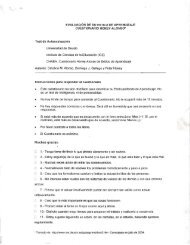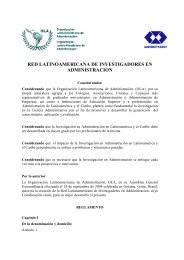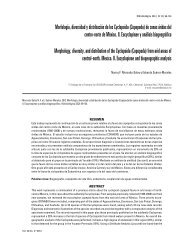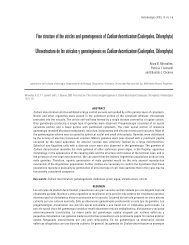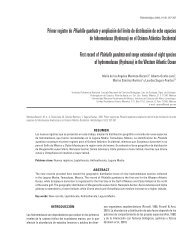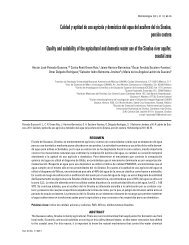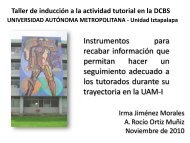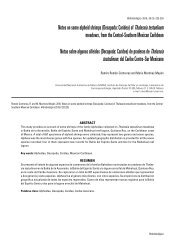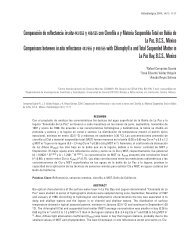21 (1): 26-33
21 (1): 26-33
21 (1): 26-33
You also want an ePaper? Increase the reach of your titles
YUMPU automatically turns print PDFs into web optimized ePapers that Google loves.
Records caridean shrimps western Mexico 31Superfamilia Processoidea Ortmann, 1896Familia Processidae Ortmann, 1896Processa cf. aequimana (Paulsson, 1875)Material examined.- Bahía Algodones, San Carlos (27°57’0”N,111°5’42”W), 1 specimen, 25/Mar/1997, 3 m, scuba diving (EMU-8818). Beach at Punta Mita, near village (20°47’20”N, 105°31’5”W),3 specimens, 12/Nov/2004, rocky intertidal (EMU-8834).Previous geographic records.- Upper Gulf of California,Mexico, to Mazatlán. Also in the Indo-West Pacific (Wicksten &Hendrickx, 2003).Remarks.-The record from Punta Mita extends the range ofthis species in the eastern Pacific south by about three degrees oflatitude. The record from Bahía Algodones confirms the continuedpresence of the species within its known range. Identification ofthis material is tentative due to unresolved taxonomic difficulties.Processa peruviana Wicksten, 1983Material examined.- Off Punta Piaxtla, SIPCO III, St. C1(23°37’12”N, 106°55’54”W), 1 specimen, 16/Jan/1982, 45 m (EMU-8846). Off Banco Gordo, CORTES 1 cruise, St. 56 (23°7’0”N,109°25’0”W), 1 specimen, 13/May/1982, 82 m (EMU-8808-B). OffPunta San Marcial, CORTES 2, St. 9 (25°47’48”N, 111°4’24”W),1 specimen, 11/Mar/1985, 78 m (EMU-88<strong>26</strong>-A). Off Punta Willard,CORTES 2, St. 34 (30°11’24”N, 114°3’540”W), 1 specimen,15/Mar/1985, <strong>26</strong> m (EMU-8808-A). Off Estero Tastiota CORTES 2,St. 48 (28°16’12”N, 111°36’48”W), 1 specimen, 18/Mar/1985, 62 m(EMU-88<strong>26</strong>-B). Off Punta San Marcial, CORTES 3, St. 8 (25°<strong>33</strong>’24”N,110°59’48”W), 2 ovig. females, 30/Jul/1985, 52 m (EMU-8839). OffBahía Tepoca, CORTES 3, St. 42 (30°12’30”N, 112°50’0”W), 4 juvenilesof probably that species, 5/Aug/1985, 23 m (EMU-8823).Previous geographic records.- Southern California, USA, tosouthern Baja California, throughout the Gulf of California, Mexico,and to Peru; Islas Galápagos (Wicksten & Hendrickx, 2003).Remarks.- The frequent apparition of this species in samplestaken on the inner and mid sections of the continental platformindicates that it is a major component of the benthos communityin this habitat within the Gulf of California.Superfamilia Pandaloidea Haworth, 1825Familia Pandalidae Haworth, 1825Plesionika beebei Chace, 1937Material examined.- South of Isla San Pedro Nolasco,AA8110, St. 59-45 (27°51’0”N, 111°18’0”W), 34 specimens, 20/Oct/1981, between 0-300 m, plankton haul (EMU-8807). Off RíoFuerte, CORTES 3, St. 50 (25°49’54”N, 109°36’12”W), 1 specimen,8/Aug/1985, 93 m (EMU-8824).Previous geographic records.- Southern California, USA, toSouthern Baja California; central and southern Gulf of Californiato Peru (Wicksten & Hendrickx, 2003).Remarks.- There are only six records for this species in theGulf of California (Hendrickx & Wicksten, 1989; Hendrickx & Estrada-Navarrete,1996), some from plankton nets, others from bottomtrawls, but P. beebei certainly is a pelagic species incidentallycollected in bottom trawls rising to the surface (Hendrickx & Estrada-Navarrete,1996).Plesionika trispinus Squires & Barragán, 1976Material examined.- Off Isla Altamura, TALUD II, St. 41,(24°53’30”N, 108°40’12”W), 1 specimen, 29/Mar/1990, <strong>21</strong>1 m (EMU-8850).Previous geographic records.- Southern California, USA; SEGulf of California, Mexico, to Peru (Wicksten & Hendrickx, 2003).Remarks.- The record from Altamura slightly extends thenorthern range limit of this species by about half a degree oflatitude. There are only three previous records for this specieswithin the Gulf of California and one off the west coast of the BajaCalifornia Peninsula. There is, however, not a single record of itbetween the SE Gulf of California and the area corresponding toColombia-northern Peru (Hendrickx & Estrada-Navarrete, 1996).DiscusionConsidering the fact that the Pacific coast of Mexico extendsfrom the USA border to the border of Guatemala and covers partof the Californian zoogeographic province, the Cortés province,the Mexican province, and the northern end of the Panamic province(Espinosa-Pérez & Hendrickx, 2006), any new data related tospecies distribution is of interest as it can bring new light on thegeneral zoogeographic patterns in the eastern Pacific. The firstrecord for Pacific Mexico of Psathyrocaris fragilis is particularlyinteresting as pelagic decapods have been poorly studied in thearea, mostly due to the cost of sampling in open sea and the factthat large, pelagic gears (e.g., Isaac-Kidds midwater trawl) haveseldom been used (Hendrickx & Estrada-Navarrete, 1996). Whenrecords of caridean shrimp are reviewed, it becomes clear thatthere is a strong bias in favour of the most common, accessible,large or colourful species (e.g., genera Alpheus, Macrobrachium).On the other hand, there is a significant lack of data on the distributionof small species of Hippolytidae and Palaemonidae, althoughthese might represent an important trophic link in shallow,coastal ecosystems. Species associated with other invertebrateslike sponges, corals or other coral-associated species, are alsopoorly known and these peculiar habitats need to be investigat-Vol. <strong>21</strong> No. 1 • 2011



